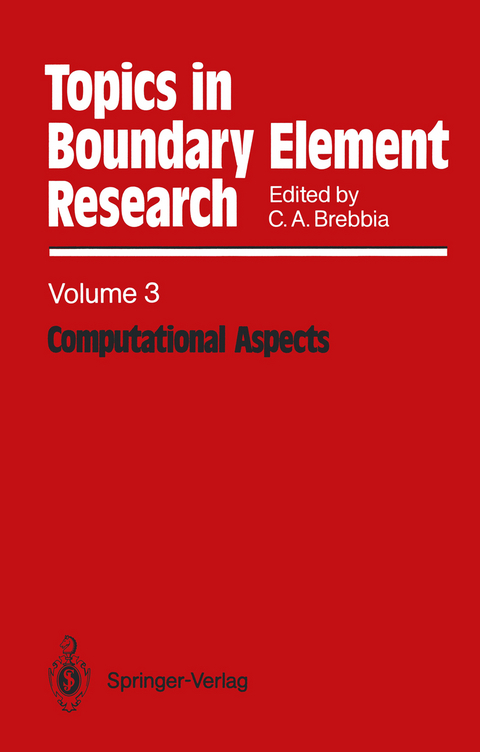
Computational Aspects
Springer Berlin (Verlag)
978-3-642-82665-8 (ISBN)
1 Numerical Convergence of Boundary Solutions in Transient Heat Conduction Problems.- Abstract.- 1.1 Introduction.- 1.2 Boundary Element Approximations.- 1.3 Convergence and Stability.- 1.4 Singularities and Unbounded Domains.- 1.5 Conclusions.- Acknowledgements.- References.- 2 New Integral Equation Approach to Viscoelastic Problems.- 2.1 Introduction.- 2.2 Preliminaries.- 2.3 Boundary Integral Equation in Space and Time.- 2.4 Alternative Approach - Incremental Formulation.- 2.5 Numerical Results and Discussion.- 2.6 Concluding Remarks.- Acknowledgements.- References.- 3 Numerical Integration.- 3.1 Introduction.- 3.2 Integration over One-Dimensional Domains.- 3.3 Integration for Two-Dimensional Problems.- 3.4 Integration for Three-Dimensional Problems.- Acknowledgements.- References.- 4 Computational Aspects of the Boundary Element Method.- 4.1 Introduction.- 4.2 Formulation and Numerical Treatment.- 4.3 A Boundary Element Program Organization.- 4.4 Storage and Management of Data.- 4.5 Data Input.- 4.6 Computation of the Matrices.- 4.7 Solution of the System of Equations.- References.- Other Bibliography.- 5 The Edge Function Method (E.F.M.) for Cracks, Cavities and Curved Boundaries in Elastostatics.- 5.1 Introduction.- 5.2 The Edge Function Method (E.F.M.) (a Qualitative Description).- 5.3 Complex Displacement Method for Elastostatics.- 5.4 Displacements and Stresses for Arbitrary Cartesian Axes.- 5.5 Basic Problems.- References.- Appendix A - Harmonic Fitting.- Appendix B - Data Inputs for 2-D Elastostatic Program "EQUINP".- Appendix C - Program EQUINP.- 6 Theoretical and Practical Aspects of Multigrid Methods in Boundary Element Calculations.- Summary.- 6.1 Introduction.- 6.2 Boundary Integral Equations.- 6.3 Approximation of Boundary IntegralEquations.- 6.4 Practical Aspects of Multigrid Methods.- 6.5 Smoothing Property of the Relaxation Process.- 6.6 Theoretical Aspects of Multigrid Methods.- 6.7 Numerical Results.- 6.8 Conclusions and Recommendations.- References.- 7 Complex Variable Boundary Elements in Computational Mechanics.- 7.1 Introduction.- 7.2 A Complex Variable Boundary Element Approximation Model.- 7.3 The Analytical Function Defined by the Approximator $$hat omega left( z right)$$.- 7.4 A Constant Boundary Element Method.- 7.5 The Complex Variable Boundary Element Method.- 7.6 Approximation Error from the CVBEM.- 7.7 A CVBEM Modeling Strategy to Reduce Approximation Error.- 7.8 Expansion of the Hk Approximation Function.- 7.9 Upper Half Plane Boundary Value Problems.- 7.10 The Approximate Boundary for Error Analysis.- 7.11 Locating Additional Nodal Points on ?.- 7.12 Sources and Sinks.- 7.13 Regional Inhomogeneity.- 7.14 The Poisson Equation.- 7.15 Computer-Aided-Analysis and the CVBEM.- References.- 8 Potential Problems.- 8.1 Introduction.- 8.2 Review of the Theory.- 8.3 Numerical and Computational Aspects.- 8.4 Description of the Computer Program.- 8.5 Applications.- References.- 9 Elastostatic Problems.- 9.1 Introduction.- 9.2 Outline of Theory.- 9.3 Numerical and Computational Procedures.- 9.4 Computer Program.- References.
| Erscheint lt. Verlag | 15.12.2011 |
|---|---|
| Reihe/Serie | Topics in Boundary Element Research |
| Zusatzinfo | XIV, 296 p. |
| Verlagsort | Berlin |
| Sprache | englisch |
| Maße | 156 x 244 mm |
| Gewicht | 502 g |
| Themenwelt | Naturwissenschaften ► Physik / Astronomie ► Mechanik |
| Schlagworte | Elasticity • Elastostatics • Mechanics • stability • statics |
| ISBN-10 | 3-642-82665-2 / 3642826652 |
| ISBN-13 | 978-3-642-82665-8 / 9783642826658 |
| Zustand | Neuware |
| Haben Sie eine Frage zum Produkt? |
aus dem Bereich


